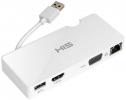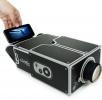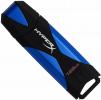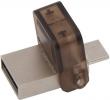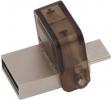Reviews related to : USB
The lack of ports is often a problem for a lot of small Tablets as they have as little as a single USB ‘C’ port, this means that unless everything is online you need a hub; earlier hubs were full size USB offerings. This hub is right up to date being USB ‘C’ and the only driver you might require is if you decide to use the HDMI port to output your display to it.
This 6 Port USB ‘C’ Hub from D-Link measures 9.5x4.5x.8cm and it weighs only 66grams. There is a 15cm hard wired USB ‘C’ lead emerging from one end. The back has a full size HDMI port and a USB ‘C’ port. The front has two USB3 ports a SD card socket and a micro SD card socket to make the units six ports.
This is an aluminium alloy mouse mat (Mousepad) but apart from controlling your mouse it lets you get extra USB ports via lead supplied as well as a Gigabit Ethernet port and both SD and Micro SD ports. So your notebook – even USB ‘C’ only now has standard USB3 and more on tap. I am told it also works with MacBooks.
The 21cm square mouse mat has a 6cm angled up extension at the back that has all the ports at the rear, the metal will not scratch the surface it is placed on as it has a grippy leather style base that also stops the pad moving. Two short leads of 15cm long each are supplied the first USB3 to USB3, second USB3 to USB ‘C’ so it does not matter if the port from the PC/Notebook/Tablet is full sized USB or USB ‘C’. My unit was silver but it is also available in grey.
While most will think of Brando as the King of anything USB this is a slightly different offering as it actually takes power from your phone for those occasions when the end of the day is a long way away but your beard needs some attention to make you look as though it is still 9AM.
Phones run for a day or so and then they need recharging. This tiny shaver takes power from your phone and fits onto its base. It would take a while to do a full shave especially for those with a vigorous beard however before you buy you need to select the type of method your phone charges either micro USB or USB ‘C’ as they are different items, I was sent the USB ‘C’ version. The shaver itself is 4.7cm long thickest at the head end where it is 2.
When struggling to cope with different USB formats, this next device might help.
Standards, especially in the field of computers, can prove useful as different companies build their kit to fit in with, and take advantage of the currently accepted methods of achieving device partnerships. However, due to their popularity, the family of Standards does tend to grow. An obvious example of this is the USB Standard which started life as a device that could be daisy-chained but that it never happened. Now we have several different USB connection formats.
This device is small but can allow a lot of things that would otherwise cause problems for those who find themselves with a USB ‘C’ port as their only easy method of getting data from either a phone or one of the growing range of Notebooks and Tablets that only have this method of transfer. I found it also worked on the SmartPhones I tested it on.
This small USB 'C' memory card reader measures 5.5x3x1cm and weighs 21 grams. The 3cm depth is increased by 1cm when not inserted as this the amount the USB ‘C’ port sticks out of the back of the hub. I use the word ‘Hub’ as when you first insert it that is what Windows calls it. The box calls it a Type-C Smart Reader but it is actually a quadruple adapter and also has an LED light on its top.
A tiny device that arrived in a small plastic sleeve and this still in a not large clear plastic envelope with the lettering USB ‘C’. It is designed to fit in any device that has a USB ‘C’ port like the majority of recent mobiles or some recent lightweight Notebook/Tablets, that are lacking the thing that most people still require a full size USB port.
It is 2cm long, 1cm wide and .1cm thick, it weights well under 1gram, yes 1gram and only just 2grams in its protective plastic holder which has a hook on one end and it clips into it. All you need to do is remove it from its holder and fit it into any USB ‘C’ port and then attach any standard USB drive and it is read by the phone or Notebook/Tablet that it is connected to.
Finding useful small items that will appeal to anyone with a phone or other electrical device at home – even for those who do not own a computer – is difficult, finding something that will get used all the time at only £3.99 is almost unique.
Power leads ending in an adapter are around and are very useful. Until now finding a socket adapter is hard, I know of a couple where you actually remove the front plate of a twin socket and then attach, - this works fine if your sockets are a standard shape - and the cheapest I have seen is around £15.
Moving files – especially larger ones – between devices like phones and PC’s has always required extra thought, the trouble is they are often last minute thoughts? Here a solution from Kingston that is as easy as plug it in to a USB port.
A while ago their solution for micro USB ports arrived here a solution if your phone has a USB C port. It is 3x1.5x.7cm and weights a tiny 4 grams. The capacity sizes available are up to 128GB the sample that I requested to be sent was 64GB simply because not all phones will accept 128GB.
The Kensington USB 3.0 hub model UA3000E provides three USB 3.0 ports as well as a Gigabit Ethernet connection and so could be a useful add on to a netbook or laptop which lacks necessary ports.
The UA3000E is a small unit which is compatible with both Windows and Macs. It will take up very little room in a laptop bag and will provide much useful connectivity. It is black in colour, weighs just 68g, is 105mm x 45 x 25mm in size and has heavily chamfered edges which give the impression that it is smaller than it actually is. The three USB 3.0 ports are along one side and, at one end, is the Gigabit Ethernet. At the other end is the 10cm long USB 3.0 cable to connect to the laptop.
Looking like what early impressions of an alien space ship might be like; a circular disc with thin sides and thicker in the middle this hub from Cygnett does but a single thing it charges your USB devices using mains power and offering five outlets around the disc.
Five equally spaced ports around the side and the sixth space is taken where the two prong mains leads is inserted. The five USB ports take 180degrees of the circle with the mains lead entering mid-way through the other half of the product. It is white in colour with blue lettering on the top and a blue band around the middle highlighting where the five charge ports are, it is 9cm across.
The datAshur USB flash drive from iStorage, available in capacities from 4 to 32GB has been designed to provide military grade protection for ones data from both unauthorised access -- electronic and physical -- as well as loss due to the drive getting damaged.
The drive is 78 x 18 x 8 mm and has a large key ring attached. It is black in colour with a 1 to 0 keypad and LEDs on one side. Its overall weight, with the supplied extruded aluminium sleeve in place, is about 25g and is fractionally larger at 80 x 20 x 10.5mm.
A rather unusual piece of kit that can be used to solve problems that you thought were not resolvable. In effect this plugs into a USB3 port to give you HDMI, VGA and Ethernet connections and increase the range of your PC/Notebook.
It is 12.5x5.5x2cm and weights 78grams with the hard wired 10cm USB plug that flips out. Often when I get to review notebooks I mention that a docking station is available to add the bits that were not on the main device, this is normally a proprietary product and has a high price as it is manufactured for a single system so made in small numbers. Here a solution to solve most of the problems from a generic box that plugs into a USB3 port.
First a Smart Phone projector for £15.95, does that sound too good to be true then read on to find out the facts. Second something that requires no assembly a red Chilli Pepper that is a four port USB hub, simple but still useful.
This is a box, a clever box but a box. If you are good at puzzles or assembling flat pack furniture then this is right up your street. There are instructions and plenty of part numbers, but the easiest way is to watch the video guide.
Our data is often personal and we like to keep it with us when out and about. This next product offers to help in this respect.
While the title of this next product might make you think of a comic book Super Hero character, I was a fan of Captain Marvel in my youth, and some might feel its functionality is such that there is a definite link in there somewhere. And of course there is the design emblem that could re-enforce the Super Hero connection but more on that a little latter.
A lot of my time recently has involved showing screens of one device on another device (Mirroring) this is a young task and the solutions sometimes do and sometimes dont work. This tiny device from Kingston is rather better at transferring data between two incompatible devices.
A few Android devices had a simple cable that connected a micro USB port to one that allowed you to insert a standard memory stick into it as if it was a standard USB port; this was a great feature that for some reason did not work with all devices. If you can persuade your Android device to show USB storage then this will normally work. To do this I found that a free App from the Play Store ES File Explorer is the most likely to give you this functionality.
Small enough to fit into your pocket, a product from Sandberg proves that not all Android devices are created equal.
TLAs (that’s Three Letter Acronyms) are not restricted to the IT sector but they are certainly a favourite with many who occupy this particular environment. One of the more recent TLAs to come to my attention is OTG with the arrival of a product from our friends at Sandberg – more on this product a little later. OTG is not to be confused with the similar OTT.
Vendors Verbatim and Kingston Technology are both using the USB OTG (On-The-Go) technology to enable users to overcome the lack of a micro-SD slot in some Android tablets or smartphones which prevents additional memory being added. This technology provides the means of expanding the storage of compatible devises to as much as 64GB.
OTG is an enhancement to the USB specification. It allows a compatible tablet or smartphone to act as a host to which flash drives and other USB devices can be attached. This is a very useful facility as it can be used to provide a device with additional memory as well as enabling files to be backed up without the need of a PC connection. Then, in due course, as the flash memory stick has a standard USB connector, it is also a simple task to subsequently transfer files to/from a PC.
As winter draws on it is becoming more and more useful to have a torch with you. Not only does the ifrogz GoLite meet this need it also provides a pocket sized universal battery backup for virtually any smartphone.
The GoLite has a polished black plastic surface and is 105mm long. It has a roughly square cross section with its gently curved sides being patterned over two-thirds of their length. This makes it easier to find the “business end” in the dark when needing to use the torch. Conveniently positioned to be reached with one’s thumb is the three-position slide switch: torch on / off / charge external device.
Offering to increase the connectivity options of your laptop is a new product from Sandberg
Modern desktop systems usually offer a reasonable collection of USB ports often split between the front and rear of the box. Currently taking up space in my work area are a couple of tower systems that feature a pair of front mounted USB ports for those occasions when you need quick and easy temporally access. Several more USB ports are located at the rear of these boxes for more permanent connection such as peripherals (scanner, printer, etc.).
Backward compatible with previous versions of the technology, the latest incarnation of USB offers various enhancements that might appeal.
Originally developed back in 1996, the Universal Serial Bus (commonly referred to as USB) was meant to be the panacea for the connection issues between computers and attached peripherals that were causing users headaches. As often happens, especially in the field of computing, the first incarnation of the technology promised more than it could deliver as it struggled to cope with compatibility and the ever-increasing demands for more speed. USB 2.












